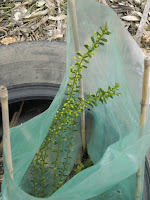July 2010. The occasional plant has been replaced (mainly with wattles - whirrakee, rough wattle, hedging wattle, most bought from local IGA) and the windbreak has been extended with (so far) 5 hedge wattles curving round at top end and along driveway. This might break cold southwest winds a bit, as these come across the paddock on adjoining hill and down drive.
Lots of mushrooms to be observed at the moment! What a pity I couldn't tell if any of them had any useful effects!
top half of windbreak, including extension around northern edge along driveway
September 2010
 Nothing is growing very fast, but hopefully spring - and recent massive rains - will spur things along. The hardiest plants remain the wattles, most of the varieties planted doing well, whereas others such as dodonia and grevillias have been very hit and miss.
Nothing is growing very fast, but hopefully spring - and recent massive rains - will spur things along. The hardiest plants remain the wattles, most of the varieties planted doing well, whereas others such as dodonia and grevillias have been very hit and miss. A few showing welcome signs of life are the dodonia left, and flowering wattles below, a rough wattle and a gold dust wattle.
November 2010
Massive spring rains have helped windbreak along. Some new plants have gone into gaps (green wattle, hedging wattle, rough wattle) seem to have settled in, and other plants, particularly golddust wattles (which are quite recent plantings) and silver wattles from previous year are showing good signs of healthy grown.
 |
| windbreak curving from street end toward the lane showing growth, on key silver wattles to form back of windbreak in particular |
Slow steady work on deepening and widening swales, and aerating ground, but it remains hard going working in this area, even after rain.
July 2011: 'Annual Report'
Good progress after wet season and plants having been established. Some plants didn't take, which wasn't unexpected given lack of soil and harsh conditions. These were replaced. Nonetheless, there is still a good range of plants growing well here, mainly acacias but also some other plants including dodonia, bursaria and saltbush, and allocasuarina. Tallest plants (silver wattles) are as tall as me! (If much wispier...)
2011/2012 Maintenance
This is a low-maintenance area. Leaf litter can be occasionally raked up around lower side of plants as mulch, especially around fire season. Selfsown cassinia and wirilda are OK retained if growing within the windbreak. Plants here shouldn't need any watering.
Build up of litter around base of the side fence and beside lane needs to be removed by start of fire season - a bonfire is good for this.
Cleared area the far side of windbreak, house side of dam, is kept as clear as possible for alternate site access and fire barrier. Rake clear when doing fire-season prep, and keep an eye out for selfsown wirilda and cassinia and remove.
July 2011: 'Annual Report'
Good progress after wet season and plants having been established. Some plants didn't take, which wasn't unexpected given lack of soil and harsh conditions. These were replaced. Nonetheless, there is still a good range of plants growing well here, mainly acacias but also some other plants including dodonia, bursaria and saltbush, and allocasuarina. Tallest plants (silver wattles) are as tall as me! (If much wispier...)
2011/2012 Maintenance
This is a low-maintenance area. Leaf litter can be occasionally raked up around lower side of plants as mulch, especially around fire season. Selfsown cassinia and wirilda are OK retained if growing within the windbreak. Plants here shouldn't need any watering.
Build up of litter around base of the side fence and beside lane needs to be removed by start of fire season - a bonfire is good for this.
Cleared area the far side of windbreak, house side of dam, is kept as clear as possible for alternate site access and fire barrier. Rake clear when doing fire-season prep, and keep an eye out for selfsown wirilda and cassinia and remove.




